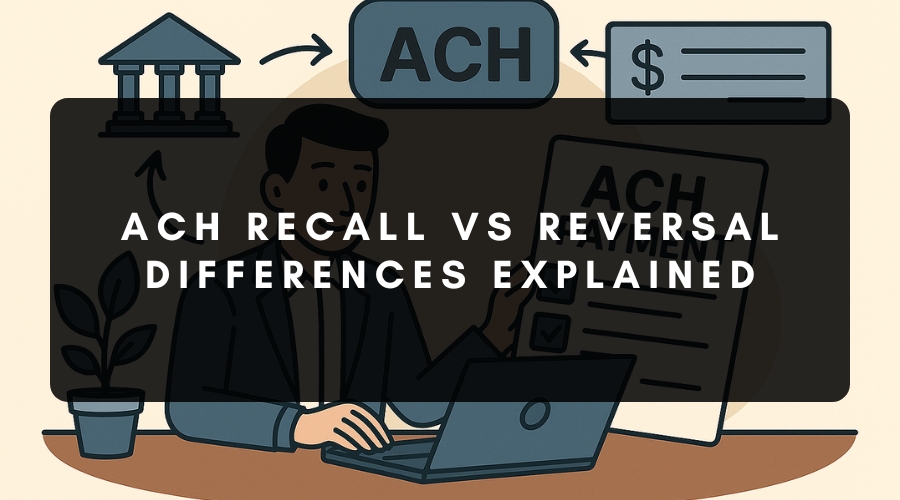
ACH Recall vs Reversal – Difference Explained
Knowing the difference between an ACH recall vs reversal is helpful for minimising disruptions to your e-commerce business. Automated clearing house (ACH) reversals correct erroneous transactions. ACH returns are initiated when a transaction fails before funds are transferred.
Both of these processes work to ensure the accuracy of digital payments and protect your business’s cash flow. Having systems in place to prevent them from happening in the first place is important because they incur additional fees.
Key Differences Between ACH Returns and Reversals
ACH recalls (AKA returns) and reversals differ by the initiator, why they occur, when they occur, and the notification process. Understanding how ACH works is a must for European-based businesses with branches in the U.S. or who want to offer this payment option to U.S.-based customers.
The main differences between ACH recall and reversals include:
Who Initiates the Failed Transaction:
- ACH returns are typically processed by the receiving depository financial institution (RDFI). When an ACH payment fails for whatever reason, it is flagged for review in the ACH system.
- ACH reversals are initiated by the originating depository financial institution (ODFI) after an incorrect payment has been processed. This occurs to rectify mistakes like incorrect amounts or duplicate payments.
Timing:
- ACH returns occur after the transaction has already been processed.
- ACH reversals are initiated before the transaction has been settled.
Notification Process:
- The RDFI identifies the issue and notifies the payment originator during an ACH return.
- ACH reversals are identified and initiated by the payment originator. The ODFI then notifies the service provider and/or recipient.
Do ACH Recalls and Reversals Incur a Fee?
Both ACH recalls and reversals incur a fee. An ACH return charge tends to be higher than a reversal charge.
Why Do ACH Returns Occur?
ACH returns occur for many reasons, including:
- Invalid account information: Typos or manual data issues can lead to mistakes in the account information field. If the information is incorrect or the account doesn’t exist, the ACH transaction will be returned.
- Insufficient funds: ACH transactions are often returned when the sender doesn’t have enough funds to cover the transaction. However, some banks allow the ACH to go through despite insufficient funds being available if they have overdraft protection or another fallback measure.
- Wrong name on the account: The name on the transfer and the financial institution’s name on file must be the same. This is to prevent fraud and ensure accuracy.
- Invalid account: Customers often change their bank account information without telling businesses. This leads to ACH returns in recurring billing transactions.
- Unauthorised transfer: The account holder must authorise transactions. They can withhold authorisation if the transfer was accidental or resulted from fraud.
How Long Does an ACH Return Take?
Most ACH returns are completed within two business days. However, disputed returns can take much longer.
Why Do ACH Reversals Occur?
ACH reversals typically occur because of an error with the transaction. There’s usually no dispute over the reversal when both parties agree there’s an error. Common errors that lead to an ACH reversal include:
- Incorrect recipient: ACH transfers sometimes go to the wrong person or account. In this case, the sender can initiate an ACH reversal request to retrieve the funds.
- Duplicate transactions: Issues with automation or billing errors can lead to duplicate transactions.
- Wrong amount: The ACH reversal process can retrieve incorrect funds when the sender makes a transaction for the wrong amount.
- Fraud: A reversal can be initiated to retrieve funds from fraudulent transactions. Other steps should also be taken to find the source of the fraud.
- Technical problems: Duplicate billings or payments can sometimes occur due to a glitch in an automated system.
- Wrong date: Human error can cause payments to be sent on the wrong date.
The ACH network moved more than $3.2 trillion in 2024. The sheer volume of transactions makes some errors inevitable. However, it’s critical to prevent mistakes on your end. A key part of this is double-checking the details before sending funds.
How Long Does an ACH Reversal Take?
An ACH reversal transaction typically takes one to five business days to process. The timeframe is influenced by factors like when the reversal request was initiated, the processing times of the bank or financial institution, and the complexity of the issue.
Important: Reversal requests must be initiated within five banking days of the transaction’s settlement date.
Impact of ACH Recalls and Reversals
Avoiding ACH recalls and reversals is important for businesses due to their financial and reputational impact. Consequences of ACH recalls and reversals include:
- Financial Disruption:
-
- Delayed revenue: Reversals disrupt cash flow. This is potentially damaging for businesses that rely on timely payments.
- Additional costs: Businesses may incur fees like an ACH return charge for processing reversals or dealing with the consequences of failed transactions.
- Operational Challenges:
-
- Increased administrative burden: Investigating reversals, correcting errors, and communicating with customers and banks require time and resources.
- Reconciliation issues: Reversals can complicate accounting processes and make it challenging to reconcile accounts accurately.
- Customer Relationship Management:
-
- Negative customer experience: Reversals, particularly those due to merchant errors and unauthorized transactions, damage customer trust and satisfaction.
- Need for resolution: Businesses must handle reversals promptly and professionally to mitigate damage to customer relationships.
- Reputational Damage:
-
- Increased scrutiny: A high volume of reversals or returns raises red flags with banks and payment processors, potentially leading to increased scrutiny or penalties.
- Loss of credibility: Frequent payment issues can erode a business’s reputation and make it more difficult to attract and retain customers.
How to Minimise ACH Recalls and Reversals
Minimising ACH recalls and reversals requires preventative measures. An experienced ACH payment processor will help you prevent issues at your end for a high percentage of smooth transactions.
The following steps will help you reduce ACH recalls and reversals:
- Keep accurate and up-to-date customer information: Inaccurate bank account numbers, addresses, or routing numbers will lead to issues when processing payments. Pay close attention to detail before initiating transactions.
- Recurring payments: Setting up recurring payments reduces human error because the customer’s correct account details are saved in the system for future use.
- Notify customers about upcoming payments: Warn customers when and how much your business will debit with enough time for them to make sufficient funds available or cancel their recurring payment.
- Use powerful fraud detection technology: Work with a payment processor with comprehensive fraud prevention tools to avoid ACH returns due to fraud.
How to Set Up ACH Payments in Europe
Offering ACH payments is a great way for European e-commerce businesses to sell to the U.S. market (through a U.S. branch or subsidiary).
You’ll need a secure web form or encrypted e-mail service to receive your customers’ bank account information. Your payment processor will then initiate recurring ACH transactions. You’ll see your U.S. sales reflected in the sales report provided in your merchant services package.
Be aware that ACH payment processing doesn’t involve the same steps as accepting credit card payments as they aren’t processed through a payment gateway. That’s why partnering with a payment processor with experience in accepting alternative payment methods—and in a large number of currencies—is a must for businesses with a global outlook.
Prevent Unsuccessful ACH Transactions
Opening up your business to U.S. customers can potentially catapult your revenue. Accepting ACH payments is a crucial step that will help you meet your new customers’ expectations and encourage repeat business.
Having the right systems in place will help your business accept ACH payments while minimising disruptions due to failed or fraudulent transactions. Partner with a payment processor that will protect your business while opening it up to a global customer base.

